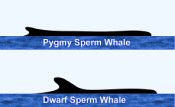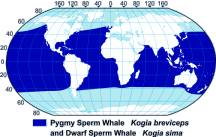Pygmy Sperm Whale
CLASS: Mammalia
ORDER: Cetacea
SUBORDER: Odontoceti
FAMILY: Kogiidae
GENUS: Kogia
SPECIES: breviceps
Pygmy sperm whales and their close relatives the dwarf sperm whales have similarities to the great sperm whales after which they are named, but they are classified into a different family. Like the sperm whales, the pygmy sperm whale has teeth in the lower jaw only (the dwarf sperm whale has up to three pairs of teeth in the upper jaw as well).
Physical Description
The forward part of the body of the pygmy sperm whale is stocky, but it rapidly becomes more tapered and narrow behind the dorsal fin. Its head is squared with a small, underslung lower jaw containing 12-16 sharply curved pairs of teeth. The upper jaw has no teeth, but contains a series of sockets that the lower teeth fit into. Stranded pygmy sperm whales have often been confused with sharks because the head and lower jaw are somewhat shark-like in appearance. On each side of its head is a light, bracket-shaped mark banded by a darker line that resembles the gill slits of fish; this has been called a "false gill". Just forward of the eye on some of these animals is another light, circular marking. A single blowhole is located above the eyes slightly forward and left of center; the blow is projected forward instead of vertically.

Surface Characteristics
Color
Its body is blue-gray to black above, shading to light gray on the sides and soft white to pink on the belly.
Fins and Fluke
Its flippers are located behind and below the "false gill" and are large and slightly rounded at the tips. A very small, curved dorsal fin is located behind the midsection. The flukes are almost dolphin-like with a deep notch in the center.
Length and Weight
Length averages 10 feet (3 m) for both sexes. Maximum length of adults is 14 feet (4.25 m); maximum weight is 900 pounds (408 kg).
Feeding
The pygmy sperm whale mostly eats octopus and squid, but it also eats crab, fish, and shrimp.
Mating and Breeding
Males sexually mature at 9-10 feet (2.7-3 m), females at 8-9 feet (2.6-2.7 m). There is some evidence that these whales are able to reproduce each year. Calves are about 4 feet at birth (1.2 m) and weigh about 120 pounds (55 kg). Most calving seems to take place between spring and autumn. The gestation period is about 11 months.

Range Map
Distribution and Migration
Pygmy sperm whales may be found in all temperate, sub-tropical, and tropical waters. As far as we know they don't migrate.
Natural History
These small whales may be found alone or in groups of 3-5 animals. They are slow swimmers and they tend to avoid ships, so they are not commonly seen at sea except by cetacean biologists diligently looking for them. Strandings are common to this species, especially in some areas of southeast coast of the United States, and often they strand alive either as single individuals or cow calf pairs. Many have been taken to aquariums where all efforts to keep them alive have been unsuccessful.
Status
Worldwide population figures for the pygmy sperm whale are unknown, but they are not considered endangered.
Bibliography
- Folkens, P., R.R. Reeves, B.S. Stewart, P.J. Clapham, and J.A. Powell. 2002. National Audubon Society Guide to the Marine Mammals of the World. Alfred A. Knopf, New York.
- Katona, S.K., V. Rough, and D.T. Richardson. 1993. A Field Guide To Whales, Porpoises, And Seals From Cape Cod to Newfoundland. Fourth edition, revised. Washington, D.C.: Smithsonian Press.
- Leatherwood, S.L. and R.R. Reeves. 1983. The Sierra Club Handbook of Whales and Dolphins. Sierra Club Books, San Francisco.
- Jefferson, T.A., M.A. Webber, R.L. Pitman. 2015 Marine Mammals of the World: A Comprehensive Guide to Their Identification, 2nd Edition. Elsevier/AP.
Acknowledgements
- We greatly appreciate the knowledge and assistance of Mason Weinrich of the Whale Center of New England, who contributed to the revision of this fact sheet.
- Illustrations courtesy Uko Gorter, copyright © 2017 all rights reserved.
FACT SHEETS MAY BE REPRINTED FOR EDUCATIONAL OR SCIENTIFIC PURPOSES
|



